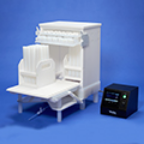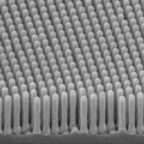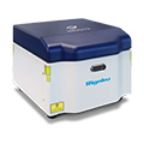|
Spectroscopy Wavelength e-newsletter
Having trouble viewing this e-mail? CLICK HERE
|
|
|
|
|
|
|
|
|
Advancing Metal-Based Anticancer Drugs with ICP-MS and Imaging MS Techniques
Metallomics approaches based on mass spectrometry have become increasingly important in the support of developing metal-based anticancer drugs. This area is a key focus for Gunda Koellensperger and her colleagues at the University of Vienna (Austria) and they recently published an article discussing this state-of-the-art instrumentation, as well as highlighting recent analytical advances, focusing especially on the latest developments in inductively coupled plasma-–mass spectrometry (ICP-MS).
Read More
|
|
|
ADVERTISEMENT

|
|
|
|
Five Reasons Why Not Every Peak Shift in Infrared (IR) Spectra Indicates a Chemical Structure Change
Spectroscopic literature often conveys the impression that peak shifts are generally related to structural changes on the molecular or unit cell level. Here, we discuss several situations in which peaks shift for reasons unrelated to chemical structural changes. To avoid misinterpretations, a practitioner should be aware of these reasons.
Read More
|
|
|
SUBSCRIBE
Subscribers can enjoy each full issue of Spectroscopy in print, or via Spectroscopy apps.
|
|
|
ADVERTISEMENT
Trading in your current discrete analyzers or FIA systems has never been faster or easier through the Lab-Forward Trade-In Program. Trade in your current Thermo Fisher Scientific instrument or an instrument from another manufacturer for credit toward one of the state-of-the-art Thermo Scientific Gallery or Gallery Plus Discrete Analyzers in our portfolio.
Learn More
|
|
|
|
|
|
|
SAS Undergraduate Student Travel Grant Applications for the SAS National Meeting at SciX 2021 Due August 15
Spectroscopic literature often conveys the impression that peak shifts are generally related to structural changes on the molecular or unit cell level. Here, we discuss several situations in which peaks shift for reasons unrelated to chemical structural changes. To avoid misinterpretations, a practitioner should be aware of these reasons.
|
|
|
ADVERTISEMENT
How to Avoid Time Traps in ICP-MS Analysis
How can you reduce the effort associated with learning a new instrument and developing new methods?
|
|
|
U.S. Food and Drug Administration Issues NIR Guidance
The guidance aids in the development, validation, and use of near infrared-based analytical procedures.
|
|
|
ADVERTISEMENT
The 2022 Winter Conference on Plasma Spectrochemistry will convene in Tucson, Arizona, January 16-22, 2022. Technical sessions comprise lectures and posters describing application, fundamental, and instrumentation developments with popular electrical plasma sources including inductively coupled plasma (ICP), glow discharge sources, microwave induced plasma, and laser-assisted plasma spectrochemistry. A three-day exhibition will feature new spectrometric instrumentation, novel sample introduction systems and automation, and sample preparation approaches.
|
|
|
XRF and ICP Analyses Reveal Secrets of Stonehenge Stones
A team of researchers at the University of Brighton in England used a combination of geochemical and statistical approaches to determine where Stonehenge’s sarsen (silcrete) megalith stones came from.
|
|
|
ADVERTISEMENT
X-Ray Fluorescence and the Pharmaceutical Industry: Implementing an Age-Old Technique
Wavelength-dispersive X-ray fluorescence (WDXRF) has for decades been widely implemented in quality control for many industries including, steel and alloy production, cement, plastics, glass, food, oil exploration and refining. It has been shown to be a highly stable, simple to operate, and reliable technique. In this podcast we will discuss the use of WDXRF, a direct analysis technique for the detection and quantification of elements/composition and elemental impurities in pharmaceuticals. On-going testing among various pharmaceutical companies has shown that it can be used to demonstrate compliance with regulations, such as ICH-Q3D and USP 232/233. However, this technique has not been fully exploited within this industry. Furthermore, we will discuss the ability to analyze final product as unadulterated pills in a non-destructive analysis.
|
|
|
|
|
Acid Vapor Cleaning System
Savillex’s VC Ultra uses high purity acid vapors to clean microwave digestion vessels in a single run. Customized racks minimize handling and acid exposure while pre-loaded cleaning profiles eliminate the need for method development.
|
|
|
|
Moxtek NanoStructure Solutions™
Savillex’s VC Ultra uses high purity acid vapors to clean microwave digestion vessels in a single run. Customized racks minimize handling and acid exposure while pre-loaded cleaning profiles eliminate the need for method development.
|
|
|
|
Next-generation Cartesian Geometry EDXRF
Rigaku NEX CG II is a new, second-generation XRF spectrometer that pushes the boundaries of EDXRF technology. Its delivers rapid, non-destructive multi-element analyses from ultra-low and trace element concentrations up to percent levels.
|
|
|
|
WEBCASTS & VIRTUAL EVENTS
|
|
|
Advances in Twin-Screw Granulation Technologies
Friday, August 13, 2021 at 11am EDT | 8am PDT | 4pm BST | 5pm CEST
|
|
|
Virtual Conference: Molecular Spectroscopy in Practice:
Raman and IR Imaging Theory and Applications
Tuesday, July 27, 2021 & Wednesday, July 28, 2021 at 9am EDT
|
|
|
Advances in FT-IR and UV-Vis: No Need for Cells in Liquid Sample Analysis
Session 1: Europe: Tuesday, September 7, 2021 at 9am EDT | 8am CDT | 2pm BST | 3pm CEST
Session 2: North America: Tuesday, September 7, 2021 at 4pm EDT | 3pm CDT | 1pm PDT
Session 3: Asia: Tuesday, September 7, 2021 at 10:30am IST | 1pm CST | 2pm JST | 3pm AEST
|
|
|
Microplastics Analysis in Minutes Not Hours
US & Europe Broadcast: Tuesday, August 24, 2021 at 9am EDT | 8am CDT | 2pm BST | 3pm CEST
US Broadcast: Tuesday, August 24, 2021 at 4pm EDT | 3pm CDT | 1pm PDT
Asia Pacific Broadcast: Tuesday, August 24, 2021 at 10:30am IST | 1pm CST | 2pm JST | 3pm AEST
|
|
|
Virtual Symposium: Advances in Trace-Metal and Nanoparticle Analysis
Thursday, September 2, 2021 at 11am – 2pm EDT
|
|
|
|
|
|
|
|








